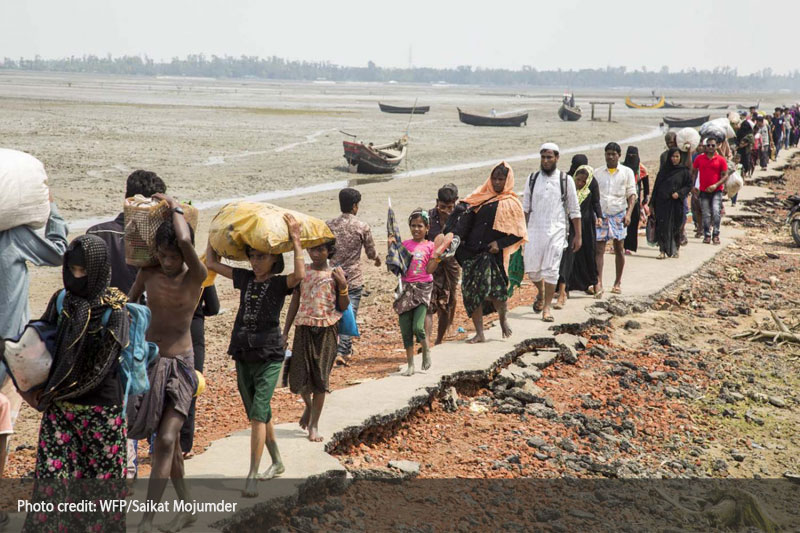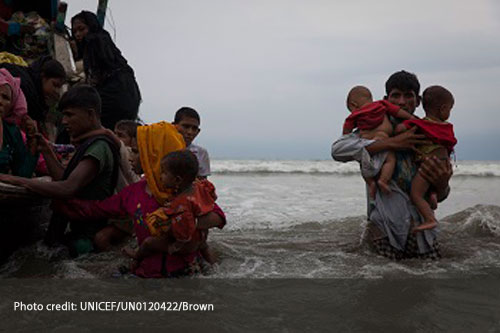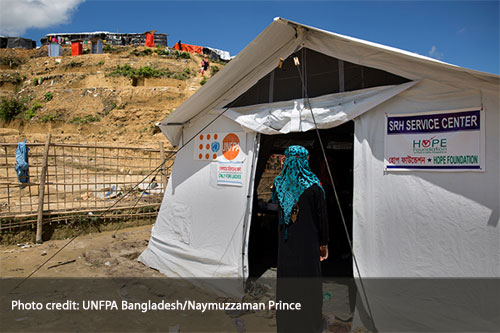UNFF Health Post at the Rohingya Refugee Camp
The humanitarian emergency

They walk for days through jungles and mountains, or brave dangerous sea voyages across the Bay of Bengal. They arrive exhausted, hungry and sick – in need of international protection and humanitarian assistance.
480,000 Rohingya refugees estimated to have fled to Bangladesh since 25 August 2017.
Violence in Myanmar’s northern Rakhine State has been brewing for years, and the most recent outbreak has resulted in an influx of Rohingya refugees to Cox’s Bazar across the border in Bangladesh.
Background
The Rohingya are a stateless Muslim minority in Myanmar. The latest exodus began on 25 August 2017, when violence broke out in Myanmar’s Rakhine State. The vast majority of Rohingya refugees reaching Bangladesh are women and children, including newborn babies. Many others are elderly people requiring additional aid and protection.
The two existing refugee camps of Kutupalong and Nayapara, established in the 1990s, were already home to over 33,000 Rohingya refugees before this influx. Now the camps’ population has soared to an estimated 77,000, well beyond existing capacity, with many new arrivals taken in by refugee families or hosted in the camps’ schools, community centres and other covered structures.
The vast majority of newly arriving refugees are now living outside the camps, in makeshift settlements and temporary shelters – often nothing more than tarpaulin held on bamboo poles. Infrastructure and services are overstretched. Other refugees continue to arrive in extremely poor condition.
What is the UN doing to help?
UNHCR, UNICEF, WFP and UNFPA are on the ground addressing the humanitarian crisis.
EMERGENCY SHELTER
UNHCR is leading the emergency response in the two camps, Kutupalong and Nayapara, where it is providing life-saving assistance and protection to the Rohingya refugees.
UNHCR is providing emergency shelter ranging from plastic sheeting to temporary bamboo sheds and using available buildings, such as schools, as temporary shelters.
UNHCR is also distributing blankets, kitchen sets, jerrycans, solar lanterns, sleeping mats, and mosquito nets. The first two UNHCR emergency airlifts carrying 3,500 relief items and 1,700 family tents arrived in Dhaka on 13 September – enough to meet the immediate needs of 25,000 refugees. Further flights are being planned.
FOOD ASSISTANCE
WFP is providing the food assistance the refugees need to survive. Since August 27, WFP has provided more than 204,600 people with High-Energy Biscuits (HEBs) as they arrive seeking shelter in already overcrowded settlements.
About 213,700 people have received warm meals — khichuri, a South Asian comfort food made with rice and lentils — through community kitchens operated by Action Against Hunger, where WFP provides the rice. These kitchens continue to provide meals for about 5,300 people per day.
WFP has distributed specialized nutritious porridge for over 5,000 mothers and children — many of whom arrived across the border hungry and malnourished after days on the move — and rice to more than 167,000 people in camps and makeshift settlements.
Those Rohingya refugees already in Bangladesh continue to receive assistance through e-vouchers or through rice and nutrition support. WFP plans to continue providing HEBs to families as they arrive, followed by 110 pounds of rice per month for four months.
The agency is carrying out food distributions to those displaced in central Rakhine State and hopes to reach 110,000 by the end of September, along with school meals for 61,000 students.
CHILDREN
UNICEF is on the ground ensuring that the most vulnerable—the children, are provided the humanitarian relief they need. And around 60 percent of the refugees are children. All told, over a quarter of a million children from Myanmar have now taken refuge in southern Bangladesh in recent weeks.

UNICEF trucks filled with emergency water, sanitation and hygiene supplies for thousands of Rohingya children are headed to Cox’s Bazar, with a steady stream of supplies in the pipeline for the coming days and weeks.
“There are acute shortages of everything, most critically shelter, food and clean water,” said Edouard Beigbeder, UNICEF’s Representative in Bangladesh. “Conditions on the ground place children at high risk of water-borne disease. We have a monumental task ahead of us to protect these extremely vulnerable children.”
UNICEF supplies include detergent powder, soap, and pitchers and jugs for containing water, along with nappies, sanitary napkins, towels and sandals. UNICEF is also supporting the Department of Public Health Engineering with water treatment plants and carriers, and is working with partners on the ground to install and rehabilitate tube wells.
UNICEF is also kicking off a vaccination campaign against measles, rubella and polio to immunize 150,000 Rohingya children below the age of 15 in 68 refugee settlements close to the border with Myanmar. The seven-day campaign is led by the Ministry of Health with support from UNICEF and the World Health Organization (WHO).
UNICEF is supporting the Ministry of Health by providing the vaccines, syringes and vitamin A capsules. WHO planned the immunization campaign and is managing and monitoring its field implementation to ensure every child is being reached.
“Measles is a very infectious and dangerous disease during emergencies, especially for children who are already weak and malnourished,” said Edouard Beigbeder, UNICEF’s Representative in Bangladesh. “With thousands of children crossing the border every day, vaccination is crucial to prevent the spread of potentially deadly diseases.”
WOMEN
For Rohingya women and adolescent girls, UNFPA is on the ground, providing services for maternal health, treatment of rape, and psychosocial counseling. Already marginalized and vulnerable, women and girls are bearing the brunt of the crisis.

UNFPA has deployed dozens of midwives, with special training in humanitarian response, to Cox’s Bazar to deliver life-saving care. These midwives are supporting the health personnel already working around the clock to meet the needs of pregnant women, new mothers and newborns. They are also responding to the medical needs of survivors of sexual violence.
And UNFPA’s women-friendly spaces are providing a safe place for women and girls to rest and receive referrals to support services, including health care, psychosocial support and counselling, and professional case management for survivors of gender-based violence.
Thousands of women and girls are also receiving UNFPA-provided dignity kits, which contain hygiene supplies such as soap and sanitary napkins, as well as flashlights to help women and girls safely navigate at night.